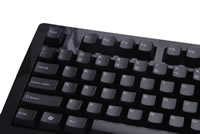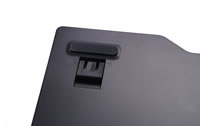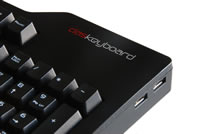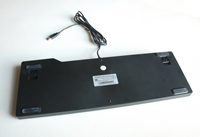Depending for how long you've been using computers or how much of a geek you are, you may have heard how old fashioned keyboards that used mechanical key switches were immensely better and built to last. We are talking about the really old keyboards here, like the ones that shipped with the original IBM PC in the early 80s.
With a whooping 64 KB of RAM and a single 5 1/4 inch floppy drive, those were serious business machines, and the IBM keyboard that came as part of that package eventually built a reputation of its own. So much in fact that the manufacturer rated each key to be good for over 100 million keystrokes.
Fast forward to the present day and you can tell priorities have changed considerably since then. Internal components are usually the ones driving sales, and the mouse is often considered the more important input device. Now, enter the Das Keyboard. A product that hopes to recapture some of the essence built into those first-gen PC keyboards, or as they bluntly put it on their website, they want to offer "the best keyboard on the planet".
The third generation of the Das Keyboard comes in two flavors: the original Das Keyboard (Ultimate) that uses totally blank keys and the Das Keyboard Professional, which adds inscriptions on the keys. We tested both versions of the product which are essentially the same excepting the above. We did this with the purpose of experiencing how the blank board could aid you becoming a touch typist per the maker's claims.
The Das Keyboard may strike you at first with its extremely plain looks compared to some other options on the market. There are no fancy LCD screens, built-in media buttons, macro keys or touch-sensitive pads. What you do get, however, is a basic keyboard layout with a glossy black enclosure, mechanical switches on every key and a built-in two-port USB hub. This minimalist look and feel is exactly what the team over Metadot was aiming for.


Both units arrived in a white retail package. Inside we found a single sheet for installation that also directs users to the Das Keyboard website to find user manual, technical data, repair and warranty information as well as a cleaning cloth and the keyboard itself.
Both keyboards feature a glossy black enclosure with matte black keys. If fingerprints tend to bother you, you will certainly want to keep that cleaning cloth close by. There is no wrist rest on either model, which can take some time to get used to if you have been using one previously. The Das Keyboard name is printed on the top right of the board above the number pad. This is also where you will find the two USB ports which are 1.1/2.0 compatible and do not require external power.

The real selling point of the Das Keyboard, however, is not aesthetics but the keys themselves and how they sound and feel when typing. Modeled after the classic IBM model M, the Das Keyboard employs mechanical gold-plated key switches that provide that same tactical and audible click that many of us grew accustomed to back in the day. One of the great things about the keys on this board is the fact they are very easy to remove which makes cleaning the unit a quick and painless task.
The underside of each keyboard reveals four large rubber feet to securely hold the board in place during typing. Each board weighs in at a whopping 2.6 pounds, so there is little chance of movement during use. Two retractable feet at the top of the board allow you to raise the unit slightly if you prefer to type on an incline.



